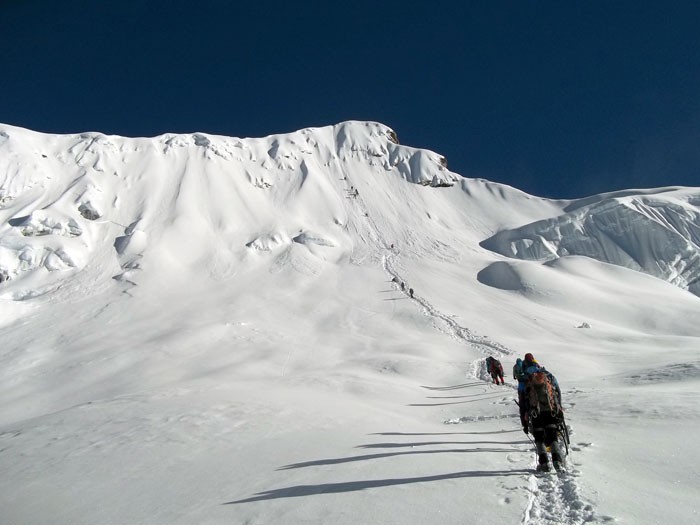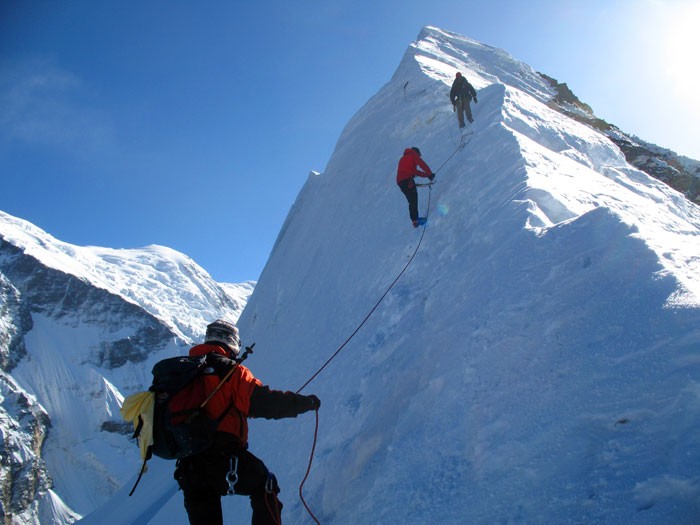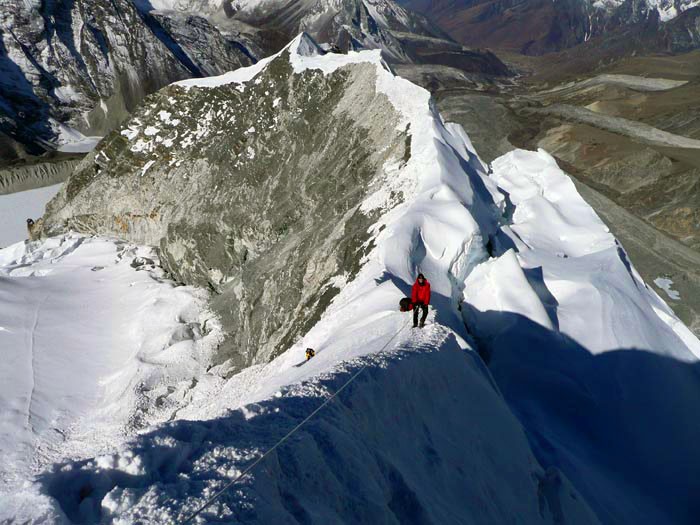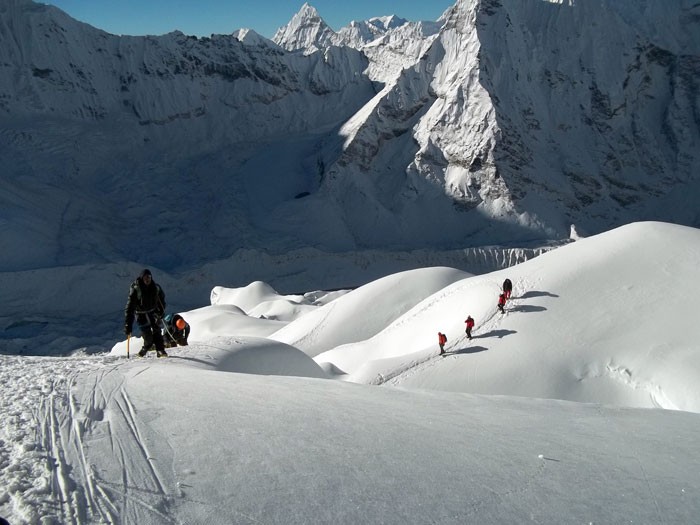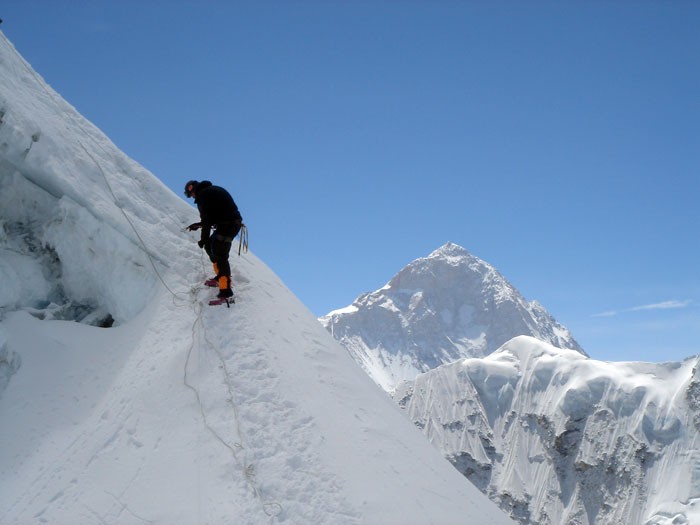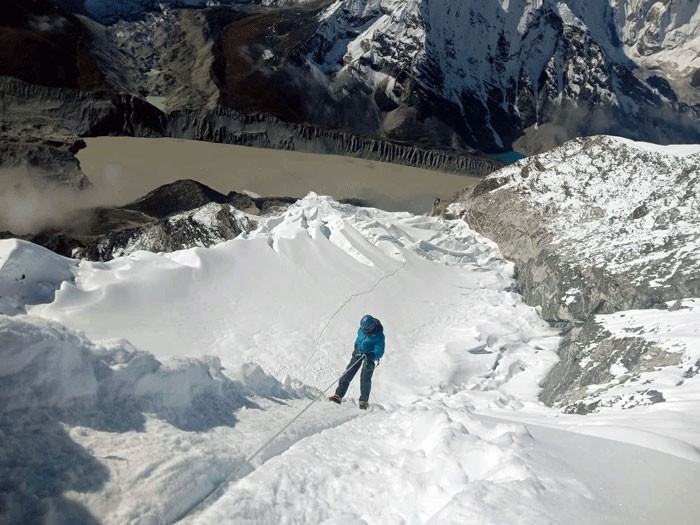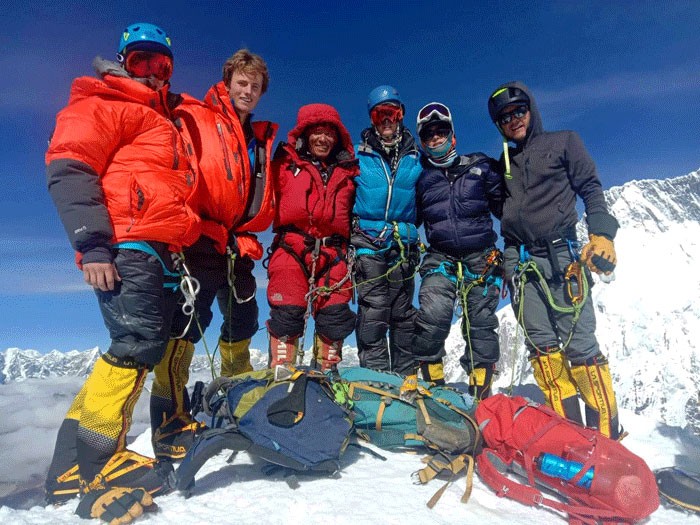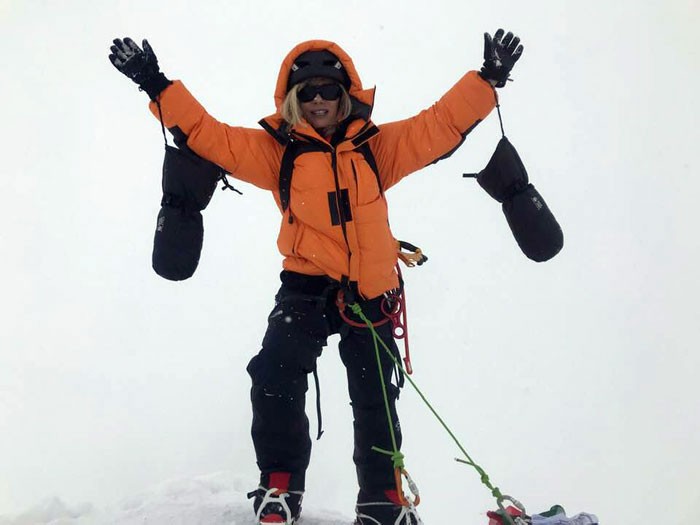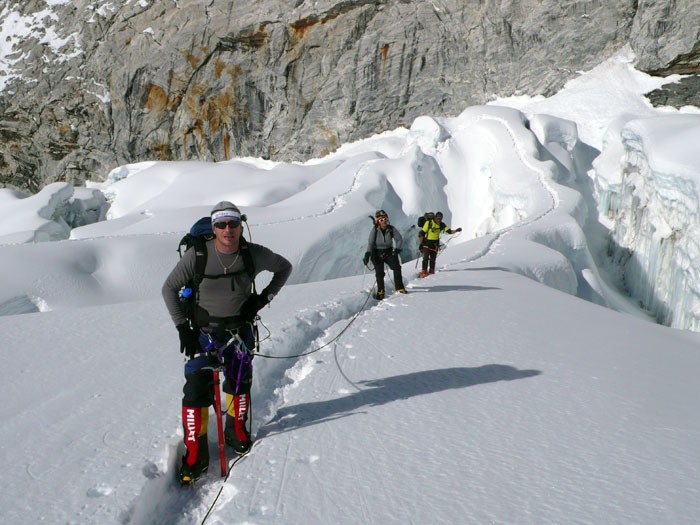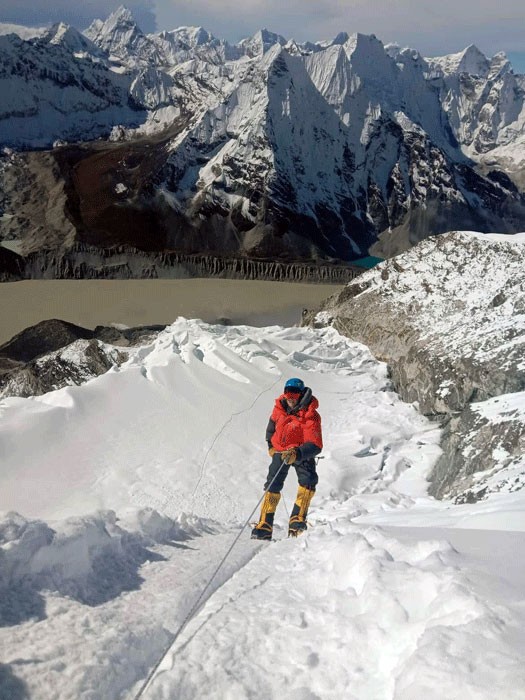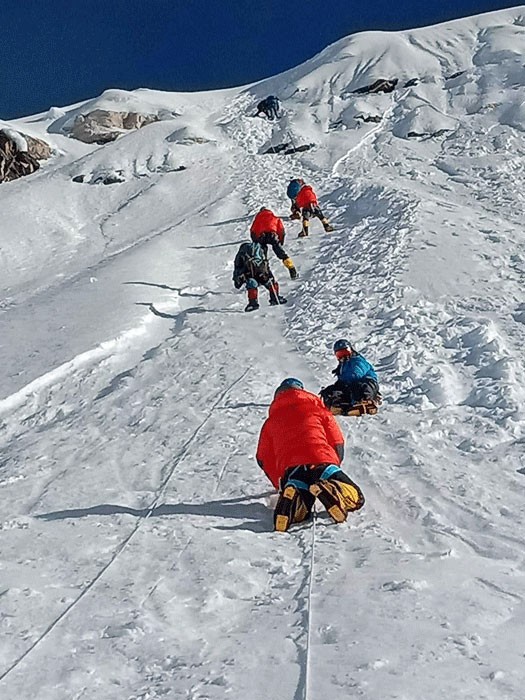Island peak - Beginner Climb/Trek Overview
Island Peak (6189m/20,305’) is probably the easiest and most affordable way to obtain high-altitude experience and see how you feel above 6,000 meters. It is also a beautiful place to take an up-close look at the high peaks around Everest, including the famous south face of Lhotse, Makalu and north side of Ama Dablam. Our proposed schedule allows for acclimatization, training, practice and rest. The trip includes a fun trek to Everest Basecamp, as well as a trek to the top of Kala Pattar.
Please watch "Island Peak Video" a very good 7 minute film by Richard Pattison.
- Fly to Lukla, trek up to Everest base camp for acclimatization, then on the way back down, side track to Island Peak and finally climb it, head back down to Lukla: 22 days.
- Fly to Lukla, trek straight up to Island Peak and climb it, then trek straight back to Lukla, without visiting Everest Base Camp: 17 days.
- Climb Island Peak as an “optional add-on” to another trek or climb, such as Ama Dablam, or Lobuche Peak: 5 days
Island Peak Expedition Cost
Our full-service climb includes:
- British, American, and European leader/coordinator
- Climbing Sherpa for the group
- All internal / domestic transport
- Full service trek to / from base camp
- Three meals per day
- Permit fees and liaison officers
- Group gear, emergency equipment, satellite phone
- Personal tents in basecamp (no sharing)
- Double occupancy tents above base camp
- Full base camp with dinning tent, bathroom
- Two nights stay in a clean comfortable conveniently located Kathmandu hotel on arrival and two nights prior to departure in a double room. Private rooms are available for a small additional fee.
5 day option: We offer a five day trip for those members that wish to meet our team on day 13 of the itinerary in Chukkung Village. Members must arrange their own trek before and after the 5 days of climbing. All of the services provided to our full-service members will be offered to members who wish to only do the 5 day program while climbing Island Peak. This can be a great option for those who are participating in other treks/climbs in the region.
- Expert climbing Sherpa
- Three meals each day
- Group emergency equipment and satellite phone
- Shared tents.
- All permit fees and liaison officers
- Access to fixed ropes
- Use of group gear and supplies
- Two nights stay in a clean comfortable conveniently located Kathmandu hotel on arrival and two nights prior to departure in a double room. Private rooms are available for a small additional fee.
- Airport transfer
What is not included?
- International flights to/from Kathmandu
- Mountain climbing rescue and travel insurance
- Personal climbing equipment and clothing
- Gratuities for staff
- Nepalese visa
- Fly to Lukla, trek up to Everest base camp for acclimatization, then on the way back down, side track to Island Peak and finally climb it, head back down to Lukla: 22 days.
- Fly to Lukla, trek straight up to Island Peak and climb it, then trek straight back to Lukla, without visiting Everest Base Camp: 17 days.
- Climb Island Peak as an “optional add-on” to another trek or climb, such as Ama Dablam, or Lobuche Peak: 5 days
Island Peak Expedition Itinerary
- 1) Arrive in Kathmandu. Stay at hotel.
- 2) Orientation meeting and gear check. Stay at hotel
- 3) Fly to Lukla 2840m (9318’). Trek to Phakding 2650 meters (8,694’). Stay at teahouse.
- 4) Trek to Namche Bazaar 3440 meters (11,286’). Stay at teahouse.
- 5) Rest, acclimate, and relax in Namche Bazaar.
- 6) Trek to Tengboche, 3900 meters (12,795’). Stay at teahouse.
- 7) Trek to the village of Pheriche, 4250 meters (13,944’). Stay at teahouse.
- 8) Trek to the village of Dughla at 4620 meters (15,157’). Stay at teahouse.
- 9) Trek to the village Lobuche, 4930 meters (16,175’). Stay at teahouse.
- 10) Trek to GorakShep, 5160 meters (16,929’). Stay at teahouse.
- 11) Trek to Everest basecamp, onthe Khumbu glacier at 5300 meters (17,388’). Stay at teahouse in GorakShep
- 12) Trek to Kala Patar, then go to Dingboche, 4530 meters (14,862 feet’). Stay at teahouse.
- 13) Trek to Chukkung Village at 4700 meters (15,420’). Stay at teahouse.
- 14) Trek to Island Peak basecamp at 5100 meters (16,732’). Camp
- 15) Rest in Island Peak basecamp and train to ascend and descend fixed ropes.
- 16) Summit Day, camp in basecamp.
- 17) Trek to Pangboche. Stay at teahouse.
- 18) Trek to Namche Bazaar. Stay at teahouse.
- 19) Trek to Lukla. Stay at teahouse.
- 20) Return flight to Kathmandu. Stay at hotel.
- 21) Extra day of rest and celebration in Kathmandu. Stay at hotel.
- 22) Flight Home.
Island Peak and Ama Dablam Expedition Itinerary
- 26 Oct - Arrive in Nepal
- 27 Oct - Orientation day, equipment checking, gear shopping and sightseeing in Kathmandu. Stay at hotel.
- 28 Oct - Fly to Lukla, 2,900 metres (9,514 feet). Easy short walk to Phakding, 2,550 metres (8,366 feet). Beautiful day of light trekking. Sleep in teahouse.
- 29 Oct - Walk to Namche Bazaar, 3,440 metres (11,286 feet). Lovely forest trek over suspension bridges. This big village is the capital of the Sherpa people. Sleep in teahouse.
- 30 Oct - Rest & Acclimatization in Namche. Teahouse.
- 31 Oct - Walk to Pangboche 3,860 metres (12,644 feet). Famous Everest base camp trekking route with many lodges and restaurants and beautiful scenery of Mt. Ama Dablam. Teahouse.
- 1 Nov - Trek to Dingboche
- 2 Nov - Rest in Dingboche.
- 3 Nov - Trek to Chukkung.
- 4 Nov - Walk to Island Peak base camp.
- 5 Nov - Climb Island Peak, return to Island Peak base camp
- 6 Nov - Walk to Pangboche
- 7 Nov - Walk to Ama Dablam Base Camp 4,570 metres (14,989 feet). Beautiful Ama Dablam basecamp is on grassy meadows. Camp.
- 8 Nov – Sherpa Prayer Ceremony (Puja) in Base Camp. Rest & Acclimatization,
- 9 Nov - Equipment check and fixed rope training day on small cliffs near base camp.
- 10 Nov - Walk to advanced basecamp, 5,350 metres (17,552 feet). Easy walking on paths. Sleep there.
- 11 Nov - Hike to camp 1, 5,700 metres (18,701 feet). A bit of rockhopping in a boulder field, followed by short easy low angle scramble to C1
- 12 Nov - Rest in Camp 1.
- 13 Nov - Climb to camp 2, 5,900 metres (19,357 feet). Easy climbing to C2 is on good solid granite, using fixed ropes.
- 14 Nov - Wake up in the night, eat "breakfast" and attempt the summit: 6,812 metres (22,349 feet). Summit attempt involves easy snow climbing with a bit of simple mixed rock just above C2. Return and sleep in C2.
- 15 Nov - Extra day for summit attempt.
- 16 Nov - Downclimb and walk down to basecamp.
- 17 Nov - Pack up and descend to Pangboche village. Sleep in teahouse.
- 18 Nov - Walk down to Namche Bazaar. Teahouse.
- 19 Nov - Walk down from Namche to Lukla. Teahouse.
- 20 Nov - Fly from Lukla to Kathmandu.
- 21 Nov - Extra day in Kathmandu, in case of delay, and for sightseeing, gift shopping, celebration, saying goodbye to new friends. Stay in hotel.
- 22 Nov - Fly back to home country.
- Fly to Lukla, trek up to Everest base camp for acclimatization, then on the way back down, side track to Island Peak and finally climb it, head back down to Lukla: 22 days.
- Fly to Lukla, trek straight up to Island Peak and climb it, then trek straight back to Lukla, without visiting Everest Base Camp: 17 days.
- Climb Island Peak as an “optional add-on” to another trek or climb, such as Ama Dablam, or Lobuche Peak: 5 days
Island Peak Expedition Leadership and Staff
Sherpas: We employ some of Nepal, Tibet, and the Karakorum’s best local mountaineers and Sherpas to assist team members in realizing their summit goals. Our friendly and loyal high altitude climbing staff has supported teams to the summits of more than ten of the highest peaks in the Himalaya.
- Fly to Lukla, trek up to Everest base camp for acclimatization, then on the way back down, side track to Island Peak and finally climb it, head back down to Lukla: 22 days.
- Fly to Lukla, trek straight up to Island Peak and climb it, then trek straight back to Lukla, without visiting Everest Base Camp: 17 days.
- Climb Island Peak as an “optional add-on” to another trek or climb, such as Ama Dablam, or Lobuche Peak: 5 days
Island Peak Expedition Personal and Team Equipment
Climbing:
- Climbing harness
- 5 meters (16 ft.) of 6mm accessory cord
- Figure 8 abseil/belay device (tube style devices, i.e. ATC will not work on fixed lines)
- Full size ascender (i.e. PetzlAscention)
- 2 locking carabiners, 1 large and 1 small
- 4 non-locking carabiners
- Ice axe with leash
- Steel crampons with anti-balling plates
- Trekking poles
- Abseiling/Rappelling Gloves
Upper Body:
- 2 cotton t-shirts
- 2 synthetic t-shirts
- 2 long sleeve synthetic shirts
- Light-weight soft shell jacket
- Medium weight insulatingjacket (fleece, down, or synthetic)
- Hard shell jacket with hood, waterproof and breathable (Gore-Tex or similar)
- Heavy down coat
- For 6,000m peaks a very warm down coat with hood or an 8,000m coat with hood
- For 7,000m peaks an 8,000m coat with hood
- For 8,000m peaks an 8,000m down coat with hood or an 8,000m suit can be used instead
Hands:
- Lightweight poly-liner gloves
- Mid-weight soft shell gloves – water/wind resistant
- Heavy- weight waterproof gloves – Gore-tex shell with removable liner
- Expedition weight mittens -Gore-tex over mitt matched polar fleece mitt liner
Head:
- Helmet
- Warm hat that covers your ears
- Balaclava
- Face mask
- Baseball hat or brimmed sun hat
- Glacier sunglasses with side shields
- Ski goggles with light and dark lenses
- Glasses with clear lenses to protect your eyes while climbing to the summit on windy nights. (cost less than 10 dollars in Kathmandu)
- Headlamp with extra batteries and bulbs
- Buff/neck gaiter
- Bandana or head scarf (optional)
Lower Body:
- Synthetic underwear
- Hiking shorts
- Hiking pants
- 2 pair lightweight thermal bottoms
- Medium or expedition weight thermal bottoms
- Polar fleece or soft shell pants
- Waterproof/breathable pants with full side zips (Gore-Tex or similar)
- Heavy insulating pants
- For 6,000m peaks: Down or synthetic pants will full zips
- For 7,000m peaks: 8,000m down pants
- For 8,000m peaks: 8,000m down pants or a 8,000m suit can be used instead
Feet:
- Boots
- For 6,000m peaks: Plastic or composite double boots (Koflach, La SportivaSpantik, etc) Modern waterproof, single boots designed for 4-5,000m peaks may be suitable if they can be worn with 2 pairs of socks and vapor barrier lines and/or they are equipped with overboots
- For 7,000m: Plastic or composite double boots (Koflach, La SportivaSpantik, etc)
- For 8,000m peaks: 8,000m boots - One-Sport Millet Everest boots or equivalent
- Sturdy leather walking boots
- Trainers, running shoes and/or sandals
- Down booties (optional)
- 3 pair med-heavy poly or wool socks
- 2 pair poly or wool liner socks (optional)
- Vapor barrier liner socks (optional)
- 2 pair lightweight trekking socks
- Cotton socks for in town
Sleeping:
- Down sleeping bag
- For 6,000m peaks: -18C or 0F
- For 7,000m peaks:-23C or -10F (If you sleep cold consider -29C or -20F)
- For 8,000m peaks: -29C or -20F (If you sleep cold consider -40C or -40F)
- An additional down sleeping bag for basecamp for the following climbs: Everest, Lhotse, AmaDablam, Manaslu, Cho Oyu, Shishapangma, Broad Peak, K2, Gasherbrum I and II, Spantik, K2/Broad Peak Everest training climb. For Mastagata a second sleeping bag is optional, but highly recommended.
- Down base camp sleeping bag should be rated to -10C or 15F (If you sleep cold consider -18C or 0F)
- Down base camp sleeping bag should be rated to -10C or 15F (If you sleep cold consider -18C or 0F)
- 2 closed cell foam kari-mats (sleeping pads) for use in basecamp and high altitude (these can be purchased inexpensively in Kathmandu)
- High quality inflatable sleeping pad designed for cold weather (Thermarest)
- Patch kit for inflatable pad
Rucksack and Travel Bags:
- Medium rucksack/backpack (50-70 litres / 3000-4500 cubic inches, can be used as carry-on bag)
- Waterproof rucksack cover (optional)
- 2 large (120+ L / 7500+ cubic inch) duffle kit bags for clothing and equipment
- Small luggage locks for duffel kit bags
Personal Hygiene:
- Female or male hygiene supplies
- 2 tubes lip sun cream
- Large tube skin sun cream (min factor 30)
- Anti-mosquito cream
- Toothpaste/brush
- Hand sanitizer gel (small-medium bottle)
- Bar of soap small towel
- Hand wipes
- Face Mask
- Hand sanitiser
- Disposable gloves
- Disinfectant wipes
Medical:
- Small personal first-aid kit. (Simple and Light) Aspirin, first-aid tape, plasters (band-aids), personal medications, etc.
- Blister repair kit
- 10 anti-diarrhea pills
- 20 anti-headache pills
- 10 cough and/or cold medicine
- Anti-altitude sickness pills: Diamox, Acetylzolamide
- 10 Stomach antibiotics: Ciprofloxacin, etc.
- 5 Azithromycin tables
- Steri pen or bottle of water purification tablets
- Cough sweets/lozenges (Halls/Stepils)
- Earplugs
- Extra prescription glasses/contact lenses and supplies
Personal Food:
- Snack food/daily energy food
- Everest training Nepal/Tibet, AmaDablam, Baruntse: 2-4kg (4.5-9lbs)
- Spantik, Cho Oyu, Shishapangma, Mustagata, Manasu: 2-5kg (4.5-11lbs)
- Broad Peak, K2, Gasherbrum I/II, K2/Everest training, Everest, Lhotse: 3-6kg (6.5-13lbs)
- Dehydrated meals (freeze-dried dinners) for summit attempt
- Everest training Nepal/Tibet, AmaDablam: 2 meals
- Spantik, Cho Oyu, Shishapangma, Mustagata, Manasu, Baruntse: 3 meals
- Broad Peak, K2, Gasherbrum I/II, K2/Everest training, Everest, Lhotse: 5 meals
- Small roll of repair tape
- Sewing repair kit
- Cigarette lighter
- Small box matches
- Compass or GPS
- Battery powered alarm clock/watch
- Camera with extra cards and extra batteries
- Nylon stuff sacks for food and gear storage
- 2 water bottles (1 litre) wide-mouth Nalgene
- Pee bottle (1litre or larger)
- Plastic cup and spoon
- Small folding knife
- Binoculars (optional)
- 4 very large, waterproof, heavy duty disposable rubbish sacks size 150-200 litre = 40-50 gallon. These are necessary for packing. thanks
- Passport, 2 extra passport photos, flight ticket, flight itinerary
- Separate photocopies of passport and relevant visa pages, proof of insurance
- Dollars, pounds, or euros cash
- Bank/ATM/Cash and credit cards
- Bathing suit/swim suit (you never know)
- Paperback books, playing cards, ipod/mp3 player, musical instruments, extra batteries, etc.
- Travel clothes for basecamp and in town
- Umbrella (optional)
- Small solar panels for personal electronics (optional)
Group Equipment:
We provide group gear, equipment, and supplies including: rope, ice, rock, and snow anchor protection, tents; stoves, fuel, walkie-talkie radios, bamboo marker wands, etcetera. A personal tent will be provided for each member at base camp. On the upper mountain, team members will share tents. In base camp, a shower, toilet, solar charger, and a dining tent will be provided
- Fly to Lukla, trek up to Everest base camp for acclimatization, then on the way back down, side track to Island Peak and finally climb it, head back down to Lukla: 22 days.
- Fly to Lukla, trek straight up to Island Peak and climb it, then trek straight back to Lukla, without visiting Everest Base Camp: 17 days.
- Climb Island Peak as an “optional add-on” to another trek or climb, such as Ama Dablam, or Lobuche Peak: 5 days
Island Peak Expedition Experience and Training
Extensive experience is not required for climbing Island Peak. The most important thing is for members to be in adequate walking fitness. You may attempt this climb as a novice and we will teach you what you need to know.
Prior to joining our group, please see your doctor and obtain the necessary permission and advice, as well as medications for travel in extremes of altitude, and also for exotic locales.
- Fly to Lukla, trek up to Everest base camp for acclimatization, then on the way back down, side track to Island Peak and finally climb it, head back down to Lukla: 22 days.
- Fly to Lukla, trek straight up to Island Peak and climb it, then trek straight back to Lukla, without visiting Everest Base Camp: 17 days.
- Climb Island Peak as an “optional add-on” to another trek or climb, such as Ama Dablam, or Lobuche Peak: 5 days
Island Peak Application Forms
Please fill out an application and return it to us with your refundable ten-percent deposit to hold your place on the team.
Island Peak Application for World Team Members (UK Office) : PDF Form or MS Word Doc
Island Peak Application for US Team Members (US Office) : PDF Form or MS Word Doc
In addition to your application, we will need the following at least two months before the Island Peak trip begins:
- Completed Payment
- Oxygen order (if any)
- Sherpa order (if any)
- Trip Registration form
- 1 Passport sized photo
- A scan of your passport identification pages
- Complete flight itinerary
- Proof of travel, accident, and repatriation insurance. We strongly recommend Global Rescue, with at least $50,000 worth of helicopter rescue insurance.
- Trip cancellation/interruption insurance is recommended
Please contact us with any questions you may have.
- Fly to Lukla, trek up to Everest base camp for acclimatization, then on the way back down, side track to Island Peak and finally climb it, head back down to Lukla: 22 days.
- Fly to Lukla, trek straight up to Island Peak and climb it, then trek straight back to Lukla, without visiting Everest Base Camp: 17 days.
- Climb Island Peak as an “optional add-on” to another trek or climb, such as Ama Dablam, or Lobuche Peak: 5 days


